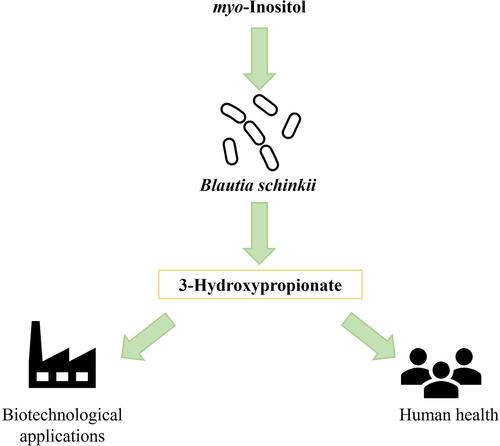当前位置:
X-MOL 学术
›
Environ. Microbiol.
›
论文详情
Our official English website, www.x-mol.net, welcomes your
feedback! (Note: you will need to create a separate account there.)
3‐Hydroxypropionate production from myo‐inositol by the gut acetogen Blautia schinkii
Environmental Microbiology ( IF 4.3 ) Pub Date : 2024-08-29 , DOI: 10.1111/1462-2920.16692 Raphael Trischler 1 , Stefanie M Rustler 1 , Anja Poehlein 2 , Rolf Daniel 2 , Milena Breitenbach 3, 4 , Eric J N Helfrich 3, 4 , Volker Müller 1
Environmental Microbiology ( IF 4.3 ) Pub Date : 2024-08-29 , DOI: 10.1111/1462-2920.16692 Raphael Trischler 1 , Stefanie M Rustler 1 , Anja Poehlein 2 , Rolf Daniel 2 , Milena Breitenbach 3, 4 , Eric J N Helfrich 3, 4 , Volker Müller 1
Affiliation

|
Species of the genus Blautia are not only abundant in the human gut but also contribute to human well‐being. Our study demonstrates that the gut acetogen Blautia schinkii can grow on myo ‐inositol. We identified the pathway of myo ‐inositol degradation through a combination of physiological and biochemical studies, genome‐wide expression profiling and homology searches. Initially, myo ‐inositol is oxidized to 2‐keto‐myo ‐inositol. This compound is then metabolized by a series of enzymes – a dehydratase, hydrolase, isomerase and kinase – to form 2‐deoxy‐5‐keto‐d ‐gluconic acid 6‐phosphate. This intermediate is split by an aldolase into malonate semialdehyde and dihydroxyacetone phosphate, which is an intermediate of the Embden–Meyerhof–Parnas pathway. This pathway leads to the production of pyruvate and, subsequently, acetate. Concurrently, malonate semialdehyde is reduced to 3‐hydroxypropionate (3‐HP). The genes responsible for myo ‐inositol degradation are clustered on the genome, except for the gene encoding the aldolase. We identified the putative aldolase Fba_3 and 3‐HP dehydrogenase Adh1 encoding genes bioinformatically and verified them biochemically using enzyme assays with heterologously produced and purified protein. The major fermentation end products were 3‐HP and acetate, produced in similar amounts. The production of the unusual fermentation end product 3‐HP is significant not only for human health but also for the potential bioindustrial production of this highly desired compound.
中文翻译:

肠道产乙酸菌 Blautia schinkii 从肌醇中产生 3-羟基丙酸
布劳蒂亚属物种不仅在人类肠道中含量丰富,而且对人类福祉做出了贡献。我们的研究表明,肠道产乙酸菌 Blautia schinkii 可以在肌醇上生长。我们通过生理生化研究、全基因组表达谱和同源性搜索相结合,确定了肌醇降解的途径。最初,肌醇被氧化为 2-酮肌醇。然后,该化合物被一系列酶(脱水酶、水解酶、异构酶和激酶)代谢,形成 2-脱氧-5-酮-d-葡萄糖酸 6-磷酸。该中间体被醛缩酶分解为丙二酸半醛和磷酸二羟丙酮,它是 Embden-Meyerhof-Parnas 途径的中间体。该途径导致丙酮酸的产生,随后产生乙酸。同时,丙二酸半醛被还原为3-羟基丙酸(3-HP)。除编码醛缩酶的基因外,负责肌醇降解的基因聚集在基因组上。我们通过生物信息学方法鉴定了假定的醛缩酶 Fba_3 和 3-HP 脱氢酶 Adh1 编码基因,并使用异源产生和纯化的蛋白质进行酶测定,对它们进行生化验证。主要发酵终产物是 3-HP 和乙酸盐,产量相似。不寻常的发酵最终产物 3-HP 的生产不仅对人类健康具有重要意义,而且对于这种高度需要的化合物的潜在生物工业生产也具有重要意义。
更新日期:2024-08-29
中文翻译:

肠道产乙酸菌 Blautia schinkii 从肌醇中产生 3-羟基丙酸
布劳蒂亚属物种不仅在人类肠道中含量丰富,而且对人类福祉做出了贡献。我们的研究表明,肠道产乙酸菌 Blautia schinkii 可以在肌醇上生长。我们通过生理生化研究、全基因组表达谱和同源性搜索相结合,确定了肌醇降解的途径。最初,肌醇被氧化为 2-酮肌醇。然后,该化合物被一系列酶(脱水酶、水解酶、异构酶和激酶)代谢,形成 2-脱氧-5-酮-d-葡萄糖酸 6-磷酸。该中间体被醛缩酶分解为丙二酸半醛和磷酸二羟丙酮,它是 Embden-Meyerhof-Parnas 途径的中间体。该途径导致丙酮酸的产生,随后产生乙酸。同时,丙二酸半醛被还原为3-羟基丙酸(3-HP)。除编码醛缩酶的基因外,负责肌醇降解的基因聚集在基因组上。我们通过生物信息学方法鉴定了假定的醛缩酶 Fba_3 和 3-HP 脱氢酶 Adh1 编码基因,并使用异源产生和纯化的蛋白质进行酶测定,对它们进行生化验证。主要发酵终产物是 3-HP 和乙酸盐,产量相似。不寻常的发酵最终产物 3-HP 的生产不仅对人类健康具有重要意义,而且对于这种高度需要的化合物的潜在生物工业生产也具有重要意义。






























 京公网安备 11010802027423号
京公网安备 11010802027423号